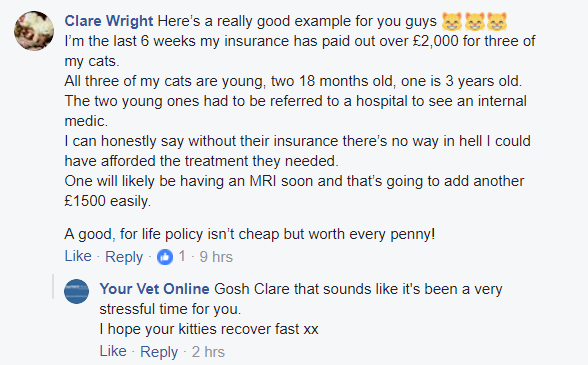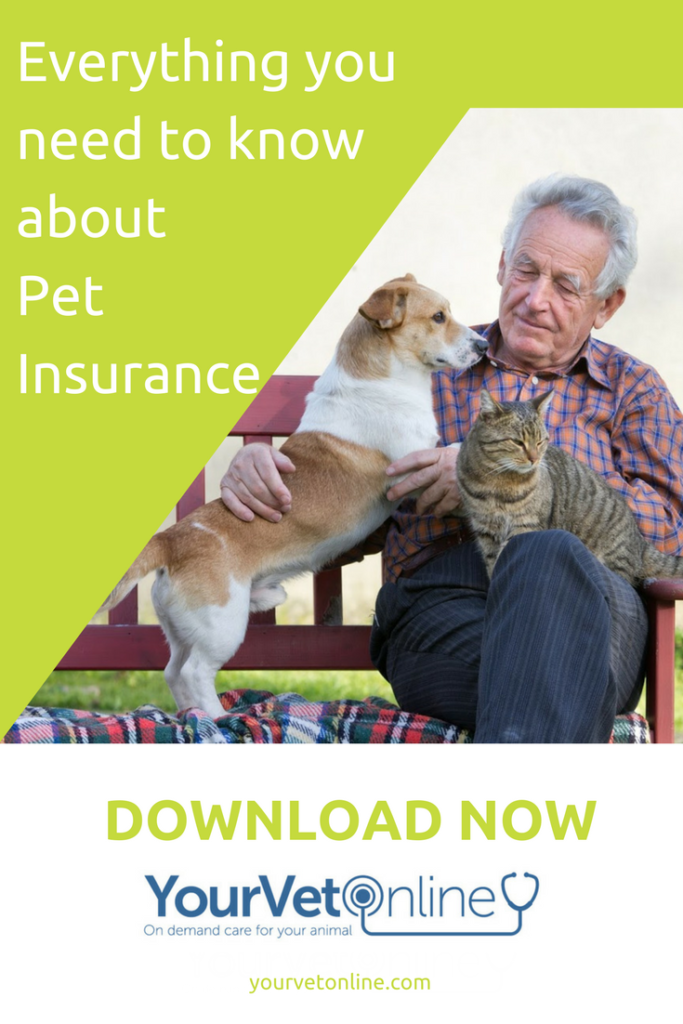Best Pet Insurance: What Do You Need To Look For
[easy-social-share]
If you ask any veterinarian the question: ‘Do I Need Pet Insurance?’ the sure-fire answer will nearly always be a resounding YES.
This isn’t because vets are in cahoots with pet insurance companies – far from it.
The real reason that veterinarians are a fan of insurance is that we see so many sick or injured animals, where the owners cannot afford the veterinary care their pet requires, and the pet needs to be euthanised.
No veterinarian likes to euthanise animals due to a lack of funds, and pet insurance can help to prevent this situation.
But, there are components of insurance that can leave you disappointed and out of pocket.
In this article, we discuss how you can choose the appropriate pet insurance product for you and your pet, so you aren’t left wondering why you bothered.

Why Choose To Purchase Pet Insurance?
As with all insurance, pet insurance is designed to reduce our risk.
The risk in this case, is that if our pets have an accident or are sick, we may be unable to afford veterinary care.
This may result in needing to euthanise our pet, or provide health care that is substandard.
We have to try and not think of insurance as something we make a return on, it is there if and when we need it, giving us peace of mind.
Some animals may never get sick or have an accident, while others are always at the vet and insurance becomes a financial life saviour for their owners.
With the cost of veterinary care increasing, purchasing pet insurance is definitely worth considering.
What Can Pet Insurance Cover?
While every policy is different – and we recommend you read the fine print closely – the peace of mind that expensive and unexpected veterinary bills are covered is the main purpose to take out insurance when you purchase a new pet.
Pet Insurance can cover a wide range of medical and surgical conditions.
Like house insurance though, you do need to check the fine print and there will most likely be an excess fee required (you set this when you take out the policy).
It is also worth noting that you may have to pay for the veterinary care upfront, and then make a claim for reimbursement later.
Some insurance companies are working on eliminating this pay now, claim later factor. This will be great news for many owners.
Types Of Insurance Cover
Pet insurance is designed for peace of mind. Remembering that, there are different types of cover available.
Accident Only
Accident Only insurance only covers your pet for accidents.
It is the cheapest cover you can buy, however, keep in mind that accidents make up less than 30% of all insurance claims, with 70% of claims being medical-related, so the cheapest may not be the best.
Be careful to read the fine print for what accidents are covered.
Many companies have very strict policies on this.
Accident And Illness
This covers your pets for accidents and illnesses.
Along with lifetime/comprehensive cover, this is the best type of policy you can buy.
Annual Cover
Annual cover is a type of premium that is renewed each year and allows you to switch plans if you need to.
While this may sound great, especially when your pet is healthy and young, remember that as soon as your pet has a problem, this will be counted as a pre-existing condition and you won’t be covered in subsequent years.
Comprehensive Or Lifetime Cover
This type of pet insurance covers your animal for a lifetime, so even as they get older or have existing conditions, these are covered (subject to conditions).
Premiums are likely to increase with age.
What Is A Stand Down Or Waiting Period
A ‘stand down’ or ‘waiting period’ means that you can NOT claim insurance for that particular problem within that time period.
Let’s say you bought insurance for your newly-adopted Staffy dog. Four months after taking out the premium he was hooning at the park and suddenly yelped and couldn’t walk on one back leg.
You rushed him off to your vet and after a thorough examination, your vet diagnosed that your boy had torn a cruciate ligament.
As this occurred four months after taking out the insurance, it is within the waiting period of six months and the claim will be rejected.
The most common waiting periods are:
- a 6mth wait period for cruciate ligament problems
- 6mths for dental disease
- 30 day stand down period for all medical illness
You do need to check your policy carefully as certain health conditions may have restrictions or not be covered at all in addition to waiting periods eg.
- Behaviour
- Dental care
Here at Your Vet Online, we suggest that you discuss with a veterinarian what health conditions your desired breed of animal may be prone to before purchasing that breed.
This means you can choose an appropriate insurance plan that covers the risk of these health susceptibilities.
If you were to get a Staffy, then you would want to look for a plan that has a high limit for skin conditions, perhaps covers behavioural conditions and has a shorter cruciate disease wait period.
What Is A Pre-Existing Condition?
One thing to remember is that pet insurance is best bought as soon as you get your dog, cat or horse.
This is because most pet insurance does not cover pre-existing conditions.
As soon as you adopt a puppy, kitten or older pet go online and purchase your insurance.
If your animal is seen to have a history of illness within the waiting time period notified in the insurance schedule (30 days for some conditions, 6mths for others) or in the time period before you took out insurance, then you may NEVER be able to make a claim on these conditions (there are some situations when you can, please talk with your provider).
Hereditary or congenital conditions can prove to be a problem.
Although provided there are no symptoms or clinical signs of these defects prior to taking out your pet’s insurance, you still may be covered.
How Insurance Claims Are Processed
When you read the fine print you will notice the words “Claims Basis” and this describes how the insurance covers vet fees.
Generally speaking, these are the following types of claims basis:
Per Condition Per Year
There is a set amount of money set for a specific condition per year ie. Skin conditions in one year maximum you can claim might be $500.
Once this limit has been reached, no more claims will be paid out for that condition (skin) in that year until the policy is renewed.
Per Year:
There is a maximum amount of cover available for all claims in one year i.e. $11,000.
Per Condition Unlimited
These policies will pay out for conditions that need treatment year after year.
What Are Policy Limits?
Many policies have a top limit payable when claims are made per year.
It is important to consider this when taking out a policy.
If you have a pet that is prone to a specific condition that may be expensive to treat it is best to ensure you choose a policy that covers your pet for the condition.
e.g. you own a Dachshund. These gorgeous dogs are prone to spinal conditions that often require surgery that can cost up to or more than $10k, so choosing a policy with a limit of $5000 may not be the best for you.
Top Tips When Choosing Pet Insurance
- Purchase insurance as soon as you get your pet. Buy a lifetime policy when they are young.
- This reduces the risk of pre-existing conditions being excluded from your pet’s cover.
- Avoid switching policies – pre-existing conditions may not be covered.
- Lower your premiums by choosing a higher excess.
- Be careful of percentage-based excess as this may prove to be expensive if your pet requires expensive veterinary care.
- Ensure you know what health conditions your animal is susceptible to and choose a policy that has good cover for these.
- Discuss this with one of our vets and we can guide you.
How To Save Money On Pet Insurance
- Purchase lifetime cover when the pet is young
- Spay or neuter your pet
- Accept a higher excess
- Put multiple animals on the same policy and receive a discount
- Check if you can include your pets on your house insurance policies
Conclusion
In the long run, pet insurance can make owning a pet more affordable, especially in your animal’s older years when medical health problems often arise.
You can compare insurance policies here.
Listen to Dr Leigh and Dr Awad discuss pet insurance in this interview here.
If you have a question about your animal that you need answering, our vets are always available. You can talk to a vet now here.







Some great points about choosing pet insurance! The availability of Accident Only, Accident and Illness, and Lifetime Cover options really helps one understand the advantages and disadvantages. An-important consideration is to get insurance before any exclusions for pre-existing conditions occur. I will seriously consider this while insuring my pet. Cheers for the good advice!!
I need to get insurance for Kilo the Pug. Nala the Cat had one serious accident and it was extremely expensive. Thanks for the options.
No worries. The sooner you get insurance the better. As you know, pugs are prone to lots of conditions, meaning that as soon as something happens, then that is counted as an exclusion. Earlier the better is my motto!
Thanks for explaining the ins and outs of pet insurance, I find it confusing when I try to figure out which one works best for me. I know a couple of people who have been dissatisfied with their pet insurance and it has made me shy away from it. At the same time, I know other people who have it and say it helped them concentrate on getting their dogs healthy again, instead of worrying about the cost.
Hey Beth, I agree it can be really confusing navigating everything especially when the companies don’t really show clearly what they do. I would recommend thinking about the following:
1. Accident and Illness
2. The breed of animal you have – is there anything specific they are prone to and is that covered?
3. This is a long term proposition. You can’t swap and change (well you can, but likely to have exclusions).
Good luck!
We do not have pet insurance for our dog Molly! I am going to do some research on it after reading your post. It is important to have coverage for our sweet dog.
Hi Sara
It is definitely worth looking into. What kind of dog is Molly and how old is she?
I had pet insurance for my many cats YEARS ago. Back then it wasn’t very fantastic. However, times have changed and it is a smart choice now!!
We agree!
I haven’t purchased pet insurance in the past, but I will certainly consider it with my next pet. I currently have a senior dog (19 years) and a senior cat (18 years) and they both now have multiple medical conditions which have added up to a few thousand dollars over the last few years. Pet insurance could have helped defray those costs, which took a chunk out of our budget.
Gosh your pets are doing well! That’s the thing Lori, when our pets are young we always think they are invincible. Like us, the older they get, often the more medical issues that pop up. Insurance is a risk game.
Very informative post! The thing I don’t like about pet insurance, at least the ones I looked into, is that you still have to pay your vet then wait for the insurance company to reimburse you. I guess getting money back is nice but that doesn’t exactly help someone who can’t afford the full cost of vet care up front, at least not if they don’t have a vet who is willing to work with them and wait for the insurance claim to be processed. When my first dog was a pup, almost 9 years ago now, I opted to open a savings account and just save as much as possible for my pets rather than paying an insurance company. That strategy has worked quite well for me, as I have enough saved up now that I don’t have to worry about money being a factor when it comes to caring for my pets.
Yes, insurance doesn’t really work like that. It isn’t any different to car insurance, house insurance etc. What I recommend is that you utilise other services like Vetpay, ZipMoney to pay the bill. You can take advantage of the first month interest free and then when you get the reimbursement you pay off the bill.
As you say a savings account is another good strategy, although many of the illnesses our pets have these days are $10k plus, that’s a lot of savings!
We have pet insurance but I have not been happy with it this year. They’ve repeatedly denied claims for things they’ve covered in the past.
Oh that’s no good at all. I would encourage you to appeal every decision. I know it’s frustrating, but you never know and sometimes the process is automated and it get’s things wrong. Good luck.